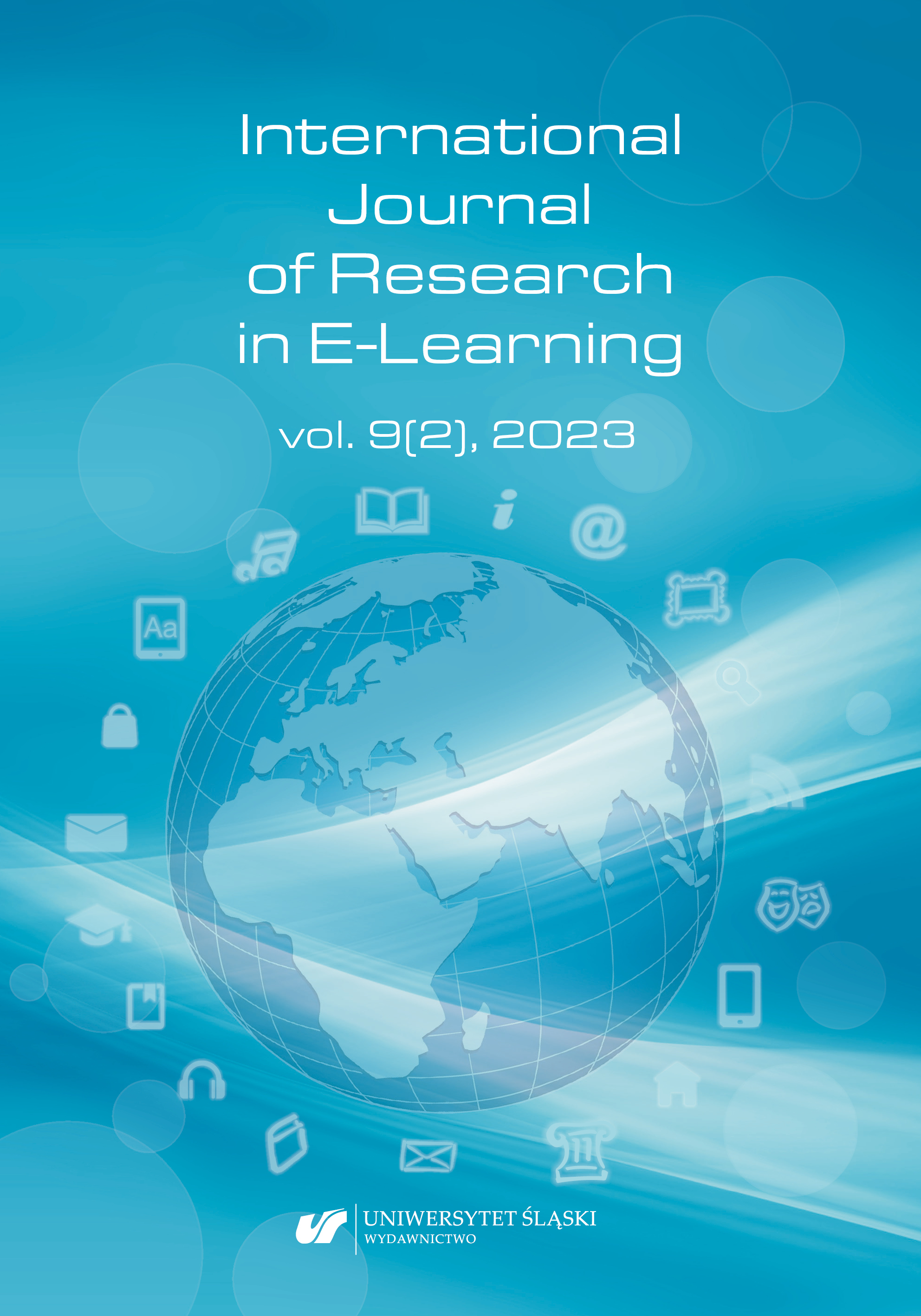Agbu, J. F., Mulder, F., De Vries, F., Tenebe, V. & Caine, A. (2016). The best of two open worlds at the National Open University of Nigeria. Open Praxis, 8(2), 111–121. https://doi.org/10.5944/openpraxis.8.2.279.
Google Scholar
Cheung, S., Wong, B. & Li, K. (2023). Perceived usefulness of open educational resources: Impact of switching to online learning for face-to-face and distance learners. Frontiers in Psychology, 13. https://doi.org/10.3389/fpsyg.2022.1004459.
Google Scholar
Colvard, N. B., Watson, C. E. & & Park, H. ((2018). The impact of open educational resources on various student success metrics. International Journal of Teaching and Learning in Higher Education, 30(2), 262–276. https://www.oer.iastate.edu/files/inline-files/IJTLHE3386.pdf.
Google Scholar
Emeka, U. J. & Nyeche, O. S. (2016). Impact of Internet usage on the academic performance of undergraduates students: A case study of the University of Abuja, Nigeria. International Journal of Scientific & Engineering Research, 7(10), 1018–1029. https://www.ijser.org/researchpaper/Impact-of-Internet-Usage-on-the-Academic-Performance-of-Undergraduates-Students--A-case-study-of-the-University-of-Abuja--Nigeria.pdf.
Google Scholar
Fabunmi, K. O. & Samuel, O. A. (2023). Psychology of Learning Relating to Assessment Using Technology in Schools: A Prognostic Discourse. Pedagogia, 21(2). https://ejournal.upi.edu/index.php/pedagogia/article/view/60755/pdf.
Google Scholar
Gambo, R. D. & Sani, M. A. (2017). Use of open educational resources and print educational materials by Federal College of Education Katsina, Nigeria: A study. DESIDOC Journal of Library & Information Technology, 37(6), 437. https://doi.org/10.14429/djlit.37.10628.
Google Scholar
Harsasi, M. (2015). The use of open educational resources in online learning: A study of students’ perception. Turkish Online Journal of Distance Education, 16(3), 74–87. https://doi.org/10.17718/tojde.46469.
Google Scholar
Hew, K. F. & Cheung, W. S. (2013). Use and Production of Open Educational Resources (OER): A Pilot Study of Undergraduate Students’ Perceptions. International Association for the Development of the Information Society. https://files.eric.ed.gov/fulltext/ED557188.pdf.
Google Scholar
Hylén, J. (2020). Open educational resources: Opportunities and challenges. https://www.oecd.org/education/ceri/37351085.pdf.
Google Scholar
Ikegulu, B. & Oranusi, S. (2014). Distance and open learning in Nigeria: Progress, concerns and prospects. Journal of Education and Practice, 5(35), 167–171. https://www.iiste.org/Journals/index.php/JEP/article/view/17699/18080.
Google Scholar
Itasanmi, S. A. (2020). OER awareness and usage among open and distance learning students in South-Western Nigeria. International Journal of Indonesian Education and Teaching ( IJIET), 4(2), 343–357. https://e-journal.usd.ac.id/index.php/IJIET/article/view/2643.
Google Scholar
Manzo, B. S. & Kannan, S. (2020). Use of social networking site by students of hassan usman katsina polytechnic. IOSR Journal of Research & Method in Education, 10(5), 24–31. https://doi.org/10.9790/7388-1005062431.
Google Scholar
Nagaiah, M. & Thanuskodi, S. (2021). Utilization of open educational resources among college students affiliated to Alagappa university in India. Linguistics and Culture Review, 5(S3), 1384–1399. https://doi.org/10.21744/lingcure.v5nS3.1822.
Google Scholar
Ofoegbu, O. T., Asogwa, U. D. & Ogbonna, C. S. (2021). Open educational resources and courseware development in dual mode universities in Nigeria. Education Tech Research Dev. https://doi.org/10.1007/s11423-021-10014-7.
Google Scholar
Okwu, E., Ogunbodede, K. F. & Suleiman, A. B. (2023). Faculty Perceptions of the Use of Open Educational Resources in State Universities in Bayelsa and Rivers States Nigeria. Asian Journal of Information Science & Technology (AJIST), 13(1), 35–40. https://doi.org/10.51983/ajist-2023.13.1.3485.
Google Scholar
Oluwayimika, K. & Idoghor, U. (2023). Awareness and Use Of Open Educational Resources And Its Benefits To University Students. Innovare Journal of Education, 11(3), 32–35. https://doi.org/10.22159/ijoe.2023v11i3.47718.
Google Scholar
Oppong, M. & Maluleka, J. R. (2022). The Use of Online Research Support Platforms among Undergraduate Students at the Kumasi Technical University in Ghana. Journal of Library & Information Services in Distance Learning, 16(3–4), 232–243. https://doi.org/10.1080/1533290X.2022.2104423.
Google Scholar
Pounds, A. & Bostock, J. (2019). Open educational resources (OER) in higher education courses in aquaculture and fisheries: opportunities, barriers, and future perspectives. Aquaculture International, 27, 695–710. https://link.springer.com/article/10.1007/s10499-019-00355-9.
Google Scholar
Raja, R. & Nagasubramani, P. C. (2018). Impact of modern technology in education. Journal of Applied and Advanced Research, 3(1), 33–35. https://doi.org/10.21839/jaar.2018.v3iS1.165.
Google Scholar
Tlili, A., Altinay, F., Huang, R., Altinay, Z., Olivier, J., Mishra, S. & Burgos, D. (2022). Are we there yet? A systematic literature review of Open Educational Resources in Africa: A combined content and bibliometric analysis. Plos one, 17(1), e0262615. https://doi.org/10.1371/journal.pone.0262615.
Google Scholar
Umar, A., Kodhandarama, B. & Kanwar, A. (2013). Can Open Educational Resources thrive in closed educational systems? Some reflections on OER in developing countries. Commonwealth of Learning, Athabasca University, 193–206.
Google Scholar
UNESCO (2015). Open educational resources. https://www.unesco.org/en/open-educational-resources.
Google Scholar
Wiche, H. I. & Ogunbodede, K. F. (2021). Awareness and use of open educational resources by Library and Information Science students of Ignatius Ajuru University of Education, Rivers State, Nigeria. Library Philosophy and Practice (e-journal). https://digitalcommons.unl.edu/libphilprac/5373.
Google Scholar
Wiley, D. & Hilton Iii, J. L. (2018). Defining OER-enabled pedagogy. The International Review of Research in Open and Distributed Learning, 19(4). https://doi.org/10.19173/irrodl.v19i4.3601.
Google Scholar
Zaid, Y. A. & Alabi, A. O. (2021). .Open Learning: Sustaining open educational resources (OER) initiatives in Nigerian universities. The Journal of Open, Distance and e-Learning, 36(2), 181–197. https://doi.org/10.1080/02680513.2020.1713738.
Google Scholar
Zimmermann, M., Mayweg-Paus, E., Ruwe, T. & Maine, F. (2023). Teacher evaluations of open educational resources designed to support dialogic cultural literacy learning in schools. European Journal of Open, Distance and E-Learning, 25, 136–147. https://doi.org/10.2478/eurodl-2023-0011.
Google Scholar


 https://doi.org/10.31261/IJREL.2023.9.2.07
https://doi.org/10.31261/IJREL.2023.9.2.07
